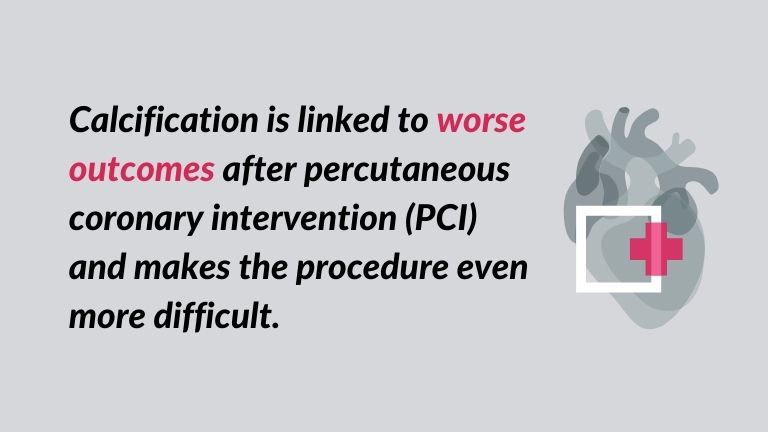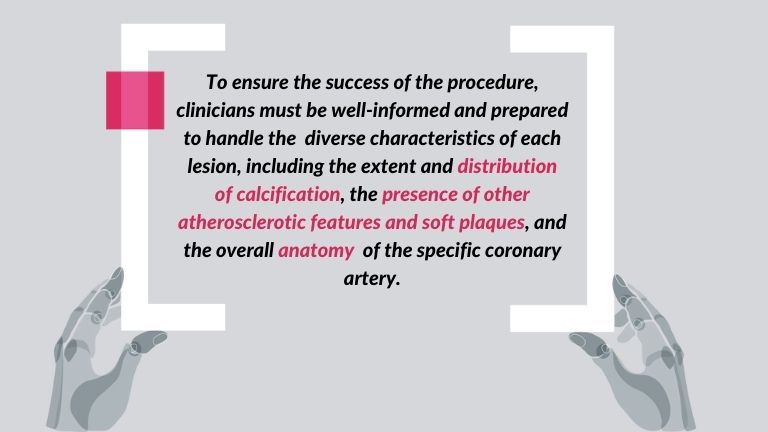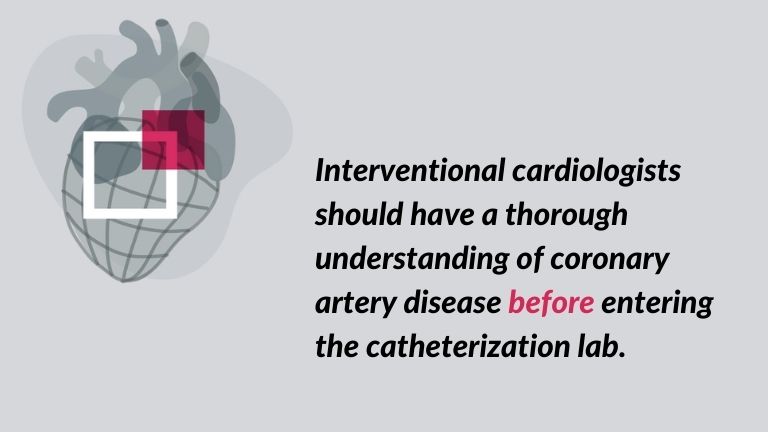Calcified coronary lesions: an interventional perspective
On our blog, you can find many entries related to calcified coronary lesions, atherosclerotic plaques in general, and cardiac image processing. We’ve also written about the ‘power of zero’ paradox, and even presented the results of our research on soft plaque analysis with four high-risk features at the recent European Congress of Cardiology in London [1]. Most of these texts focused on improving diagnosis. Today, we’d like to address the issue of coronary calcifications in the context of interventional cardiology.
The prevalence of calcified coronary lesions and PCI
This topic has been the subject of many discussions, but also complications arising during procedures performed in the Cath lab. Even at this year’s EuroPCR conference, we could familiarize ourselves with interesting presentations exploring various treatment strategies for calcified coronary lesions.
Calcification is linked to worse outcomes after percutaneous coronary intervention (PCI) and makes the procedure even more difficult. Coronary artery calcium (CAC) during PCI increases the risk of major adverse cardiovascular events (MACE). Moreover, calcified coronary lesions affect the whole preoperative planning.
HORIZONS-AMI (Harmonizing Outcomes with Revascularization and Stents in Acute Myocardial Infarction) and ACUITY (Acute Catheterization and Urgent Intervention Triage Strategy) trials showed that approximately 20–30% of patients PCI suffer from calcified coronary lesions. In fact, the real number is probably higher. Fluoroscopy’s ability of finding calcification depends on the overall volume of calcium [2]. Additionally, fluoroscopy alone can’t accurately determine the type of CAC, which also is extremely important.

Towards a personalized coronary intervention
As PCI procedures become increasingly complex, proper preparation is crucial for achieving optimal outcomes and preventing restenosis. Especially severely calcified coronary lesions pose a particular challenge due to their increased resistance to balloon dilation and stent deployment. A deep understanding of vessel anatomy and morphology remains essential, as coronary artery calcification is a known predictor of in-stent thrombosis, in-stent restenosis, and ultimately target vessel revascularization (TVR). To ensure the success of the procedure, clinicians must be well-informed and prepared to handle the diverse characteristics of each lesion, including the extent and distribution of calcification, the presence of other atherosclerotic features and soft plaques, and the overall anatomy of the specific coronary artery.
When it comes to procedural guidance, PCI has historically relied on coronary angiography. However, it has limitations. It doesn’t directly show the vessel wall or plaque. Intravascular imaging, like intravascular ultrasound (IVUS) or optical coherence tomography imaging (OCT), provides more detailed information about coronary atherosclerosis. But once again, even those modalities have their limitations. Therefore, is that it?

Strategies for calcified coronary lesions
As mentioned, accurately assessing calcification’s location and severity is essential for effective cardiological treatment. Earlier this year The Society for Cardiovascular Angiography & Interventions published an expert consensus on management of calcified coronary lesions [3]. The document gives practical advice for using various treatment methods and presents a plan for dealing with calcified coronary artery disease.
The authors describe also the process of identification of calcified coronary lesions. They indicate that procedure planning might be enhanced using non-invasive imaging. CT scans can show where and how much CAC is present, even if it’s not from a dedicated coronary CT scan. However, in our opinion the potential of this modality for interventional cardiology has been underrepresented in the mentioned document. The ongoing developments with computed tomography and artificial intelligence to aid with preprocedural planning deserves more attention.
When it comes to procedural guidance, PCI has historically relied on coronary angiography. However, it has limitations. It doesn’t directly show the vessel wall or plaque. Intravascular imaging, like intravascular ultrasound (IVUS) or optical coherence tomography imaging (OCT), provides more detailed information about coronary atherosclerosis. But once again, even those modalities have their limitations. Therefore, is that it?

Understanding the disease
Interventional cardiologists should have a thorough understanding of coronary artery disease before entering the catheterization lab. Thanks to AI-enabled advanced medical image analysis we’re now able to create a detailed 3D representation of a patient-specific coronary tree, based on cardiac CT scan only. Those 3D complete reconstructions provide a comprehensive view, including the lumen and the distribution of calcified and non-calcified plaque. Moreover, numerous studies [4] proved this technology accurately analyzes coronary artery remodeling, detects, quantifies, and classifies atherosclerotic plaque. It can even predict plaque growth using computational modeling. Thanks to these advancements clinicians can measure vessel stenosis, luminal stenosis, stenosis location, plaque burden, and plaque composition. A 3D coronary artery model allows for blood flow simulation and analysis of biomechanical factors that influence atherosclerosis but can also influence medical procedures. This information allows cardiologists to plan the procedure effectively, anticipating potential challenges and determining the necessary steps to achieve optimal outcomes.
References:
[1] https://graylight-imaging.com/blog/cardiovascular-image-analysis-ai-and-more/
[2] Sung JG, Lo ST, Lam H. Contemporary Interventional Approach to Calcified Coronary Artery Disease. Korean Circ J. 2023 Feb;53(2):55-68. doi:10.4070/kcj.2022.0303. PMID: 36792557; PMCID: PMC9932225.
[3] Riley, Robert F. et al., SCAI Expert Consensus Statement on the Management of Calcified Coronary Lesions. Journal of the Society for Cardiovascular Angiography & Interventions, Volume 3, Issue 2, 101259.
[4] Kigka V.I., George Rigas G. et al., 3D reconstruction of coronary arteries and atherosclerotic plaques based on computed tomography angiography images, Biomedical Signal Processing and Control, Volume 40, 2018, https://doi.org/10.1016/j.bspc.2017.09.009.